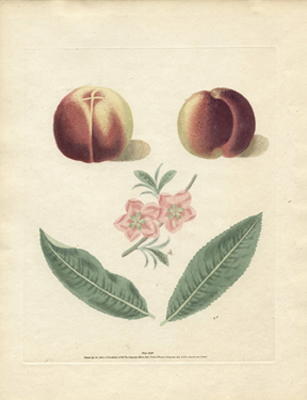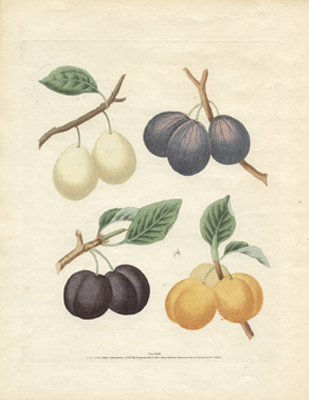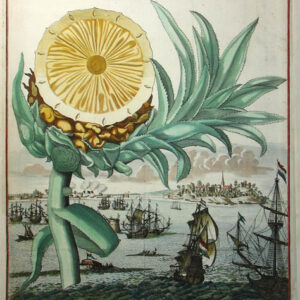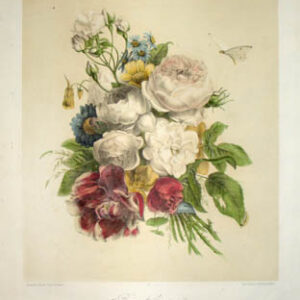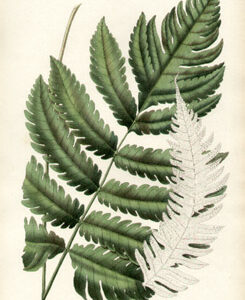Description
The folio and quarto editions of Brookshaw maintained a high quality of printing, employing the color-printed stipple method, which approximates the supple coloration, tones and textures achieved with watercolor painting. However, the folio version and the quarto version differ in various respects besides size. The folio illustrations are somewhat bolder, against dark brown backgrounds that accentuate the fruit as it seems to “jump off the page.” In contrast, the quarto edition prints are more spare and delicate against light backgrounds. Another difference is that the folio includes melons on ledges and pineapples, while the quarto does not. It may be posited that the style of the quarto plates are related to Brookshaw’s other vocations as an author of drawing instruction books and designer of painted furniture. Perhaps they were intended to serve as illustrations that would lend themselves to copying in watercolor for drawing practice or as models for decorative arts designers.
George Brookshaw was born in Birmingham, England, and early in his career taught the art of watercolor. He set up a business as a cabinet maker about 1777 and created designs for English neoclassical furniture, which are still highly prized by contemporary collectors. He supplied his painted furniture to an aristocratic and fashionable clientele until the 1790s, but after 1795 he abandoned cabinet making. Later he became a botanical artist, producing the lavish folio treatise Pomona Britannica (1804-12), depicting 256 varieties of fruit grown in Britain, many of them drawn from specimens in the Royal Gardens at Hampton Court. A smaller quarto edition of this work was issued in 1817. Brookshaw also published A New Treatise on Flower Painting; or Every Lady her own Drawing Master and two companion volumes on painting birds and fruit. He stated that these instructional manuals presented a method of painting that was so effective that he himself could not tell his pupils’ copies from his own work.
Full publication information on each print: “Painted by the Author, G. Brookshaw, & Pub’d by Longman, Hurst, Rees, Orme & Brown, Paternoster Row, & John Lepard, 108, Strand.”
Condition: Generally very good, the colors fairly bright and clear, with the usual overall light toning, wear, soiling, soft creases. Some occasional very minor pale light foxing and spotting, not obtrusive. Printed credits bottom margin slightly light on some, as issued. Disbound stitches at edge, as issued.
References:
Blunt, Wilfred, rev. by Stearn, William T. The Art of Botanical Illustration. Woodbridge, Suffolk, England: Antique Collectors Club, 1994. p. 256.
Dunthorne, Gordon. Flower and Fruit Prints of the 18th and Early 19th Centuries. Their History, Makers and Uses, with a Catalogue Raisonne of the Works in Which They are Found. Washington, D.C.: Published by the Author, 1938.50 and 52.
Henrey, Blanche. British botanical and horticultural literature before 1800. 3 vols. London: Oxford University Press, 1975. Vol. 3, 519.
MacKay, Ian. “The Brookshaw I Never Saw.” Maine Antiques Digest. August 2001.
Nissen, Claus. Die Botanische Buchillustration: ihre Geschichte und Bibliographie. Stuttgart:1951-66. 244-46.
Raphael, Sandra. An Oak Spring Pomona. A Selection of the Rare Books on Fruit in the Oak Spring Garden Library. Upperville, VA: Oak Spring Garden Library; New Haven: Distributed by Yale University Press, 1990. 40a and 40b.
Sitwell, Sacheverell. Great Flower Books, 1700-1900. New York: The Atlantic Monthly Press, 1990. p. 52.
Wood, Lucy. “George Brookshaw. The Case of the Vanishing Cabinet-maker.” Apollo. May 1991.





